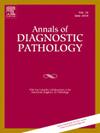Fungal Rhinosinusitis: An integrated diagnostic approach
IF 1.5
4区 医学
Q3 PATHOLOGY
引用次数: 0
Abstract
Classification of fungal rhinosinusitis (FRS) based on histomorphology and clinical presentation aids in early diagnosis and prompt patient management. In this retrospective observational study, clinicopathologic findings in patients diagnosed with fungal rhinosinusitis between January 2019 and December 2021 were evaluated. Clinical and imaging findings were retrieved from hospital records; slides from routine and histochemical studies were reviewed, and the cases were classified into non-invasive [fungal ball (FB) and allergic fungal rhinosinusitis (AFRS)] and invasive FRS [acute invasive fungal rhinosinusitis (AIFRS), chronic invasive fungal rhinosinusitis (CIFRS) and chronic invasive granulomatous fungal rhinosinusitis (CGFRS)]. Fungal cultures were also compared with histopathology. Of the 85 patients in the study, 34% were non-invasive (86% FB,10% AFRS, and 4% unclassified), and 66% were invasive (70% AIFRS, 21% CGFRS, and 9% CIFRS). The mean age of patients was 51 years, with a male-to-female ratio of 1.5:1. The most common comorbidity was diabetes with COVID-19 co-infection. Culture reports were available for 77 patients, of which 36 cases had growth, the majority of which were Aspergillus; 7 patients had coinfection with Aspergillus and Mucorales. Comparing histopathology to the gold standard mycology for Aspergillus, a sensitivity of 90%, specificity of 96%, and Cohen's Kappa of 0.8 was achieved. This study emphasizes the value of an integrated diagnostic approach in arriving at an appropriate diagnosis. In resource-limited settings, histopathological evaluation can be a valuable screening tool, aiding in early diagnosis.
真菌性鼻窦炎:一种综合诊断方法
真菌性鼻窦炎(FRS)的分类基于组织形态学和临床表现有助于早期诊断和及时的患者管理。在这项回顾性观察性研究中,对2019年1月至2021年12月诊断为真菌性鼻窦炎的患者的临床病理结果进行了评估。临床和影像学结果从医院记录中检索;回顾常规和组织化学切片,将病例分为非侵袭性[真菌球(FB)和过敏性真菌性鼻窦炎(AFRS)]和侵袭性[急性侵袭性真菌性鼻窦炎(AIFRS),慢性侵袭性真菌性鼻窦炎(CIFRS)和慢性侵袭性肉芽肿性真菌性鼻窦炎(CGFRS)]。真菌培养也与组织病理学进行比较。在研究中的85例患者中,34%为非侵入性(86% FB,10% AFRS, 4%未分类),66%为侵入性(70% AIFRS, 21% CGFRS, 9% CIFRS)。患者平均年龄51岁,男女比例为1.5:1。最常见的合并症是糖尿病合并COVID-19感染。77例患者有培养报告,其中36例有生长,以曲霉菌为主;7例合并曲霉和毛霉感染。将组织病理学与真菌学的金标准曲霉进行比较,灵敏度为90%,特异性为96%,科恩Kappa为0.8。本研究强调了综合诊断方法在达到适当诊断中的价值。在资源有限的情况下,组织病理学评估是一种有价值的筛查工具,有助于早期诊断。
本文章由计算机程序翻译,如有差异,请以英文原文为准。
求助全文
约1分钟内获得全文
求助全文
来源期刊
CiteScore
3.90
自引率
5.00%
发文量
149
审稿时长
26 days
期刊介绍:
A peer-reviewed journal devoted to the publication of articles dealing with traditional morphologic studies using standard diagnostic techniques and stressing clinicopathological correlations and scientific observation of relevance to the daily practice of pathology. Special features include pathologic-radiologic correlations and pathologic-cytologic correlations.

 求助内容:
求助内容: 应助结果提醒方式:
应助结果提醒方式:


